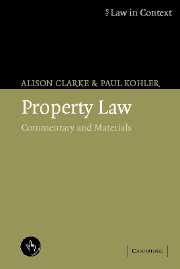Book contents
- Frontmatter
- Contents
- Preface
- Acknowledgments
- Table of cases
- Table of statutes
- Table of statutory instruments
- Table of treaties
- Table of EC legislation
- Part 1 The concept of property
- Part 2 The nature of proprietary interests
- Part 3 The acquisition and disposition of property interests
- 10 Title
- 11 Acquiring title by possession
- 12 Transfer and grant
- 13 Acquiring interests by other methods
- 14 Enforceability and priority of interests
- 15 Registration
- Part 4 Proprietary relationships
- Bibliography
- Index
13 - Acquiring interests by other methods
Published online by Cambridge University Press: 05 June 2012
- Frontmatter
- Contents
- Preface
- Acknowledgments
- Table of cases
- Table of statutes
- Table of statutory instruments
- Table of treaties
- Table of EC legislation
- Part 1 The concept of property
- Part 2 The nature of proprietary interests
- Part 3 The acquisition and disposition of property interests
- 10 Title
- 11 Acquiring title by possession
- 12 Transfer and grant
- 13 Acquiring interests by other methods
- 14 Enforceability and priority of interests
- 15 Registration
- Part 4 Proprietary relationships
- Bibliography
- Index
Summary
Introduction
There are a number of ways in which titles to, and interests in, things can be acquired and lost, apart from by express grant or transfer. Titles and interests can arise by implication of law, for example by estoppel or via a resulting or constructive trust or through the presumed intentions of the parties, as briefly noted in Chapter 8. Also, titles and interests can automatically pass from one person to another by operation of law, for example on death or bankruptcy, again as we saw in Chapter 8. In this chapter, we concentrate on another way in which interests can arise without an express grant, namely, by long user.
An interest in someone else's property can be acquired by prescription, a process which involves using someone else's property in a particular way for a sufficiently long period. The process applies not just to private property rights (notably easements and profits) but also to communal property rights, and public rights such as (but not confined to) public rights of way.
The process of acquiring a right like this by long use has obvious similarities with the process of eliminating a rival title by adverse possession but, as we see below, there are important differences between the two.
- Type
- Chapter
- Information
- Property LawCommentary and Materials, pp. 489 - 511Publisher: Cambridge University PressPrint publication year: 2005



